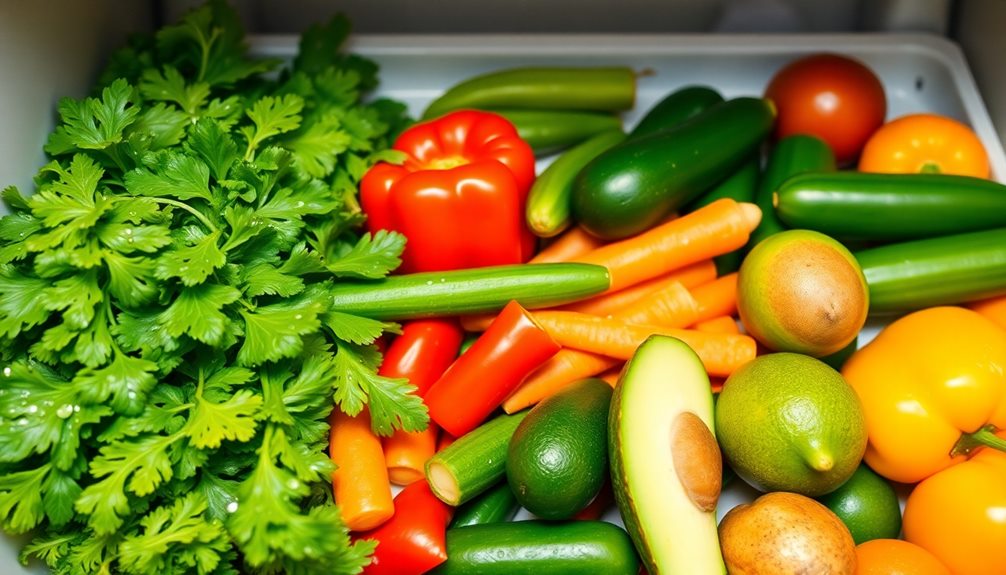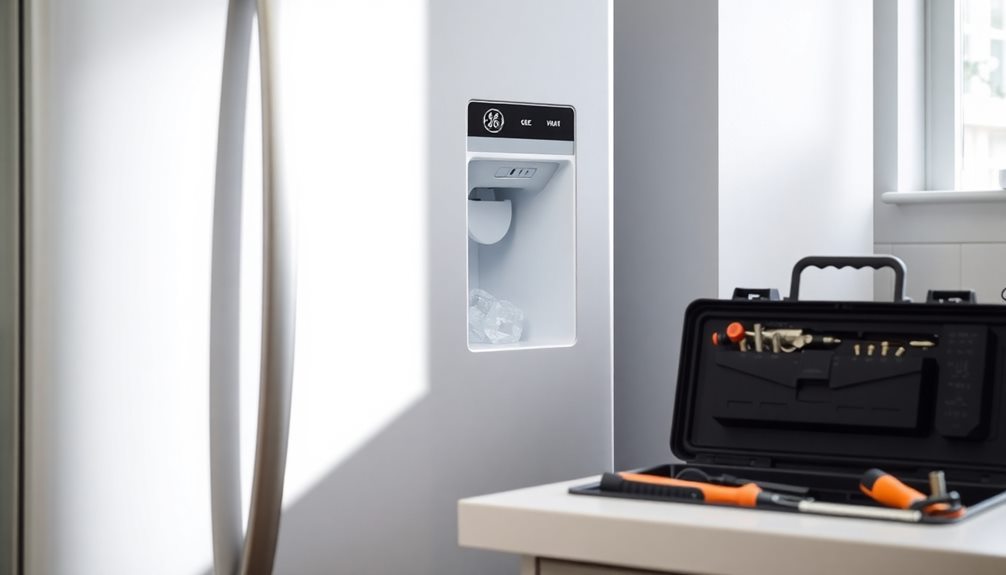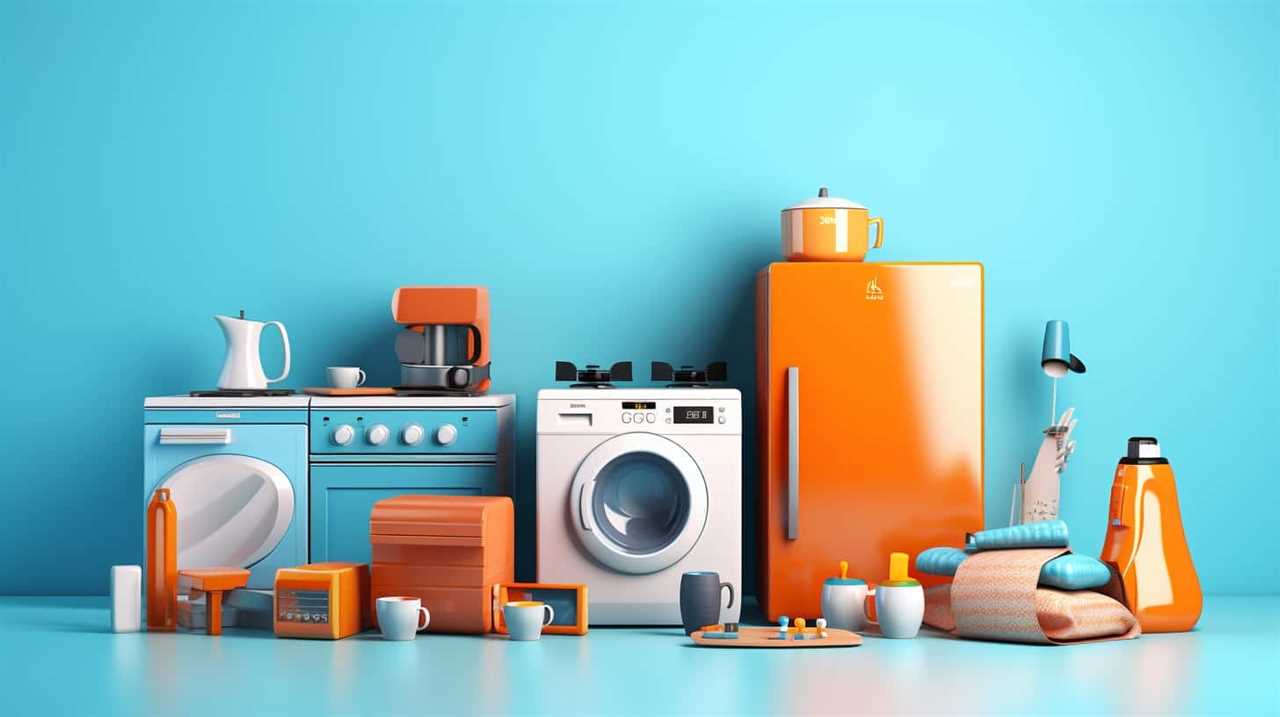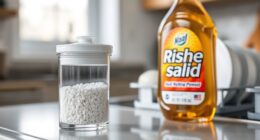The crisper drawer is your best friend for keeping produce fresh. For high humidity, store leafy greens, cucumbers, and fresh herbs like parsley and cilantro. This moisture traps in freshness and prevents wilting. In the low humidity drawer, keep ethylene-producing fruits like apples, pears, and bananas to avoid spoilage. Remember to avoid overcrowding, letting air circulate to extend shelf life. Pairing foods correctly is key to maintaining quality, so separate sensitive items from those that emit ethylene gas. Stick around, and you'll uncover even more tips to optimize your crisper drawer's potential!
Key Takeaways
- High-Humidity Drawer: Store leafy greens, cucumbers, and herbs to maintain freshness and prevent wilting.
- Low-Humidity Drawer: Keep ethylene-producing fruits like apples and avocados to prevent rapid spoilage.
- Avoid Overcrowding: Ensure proper airflow to minimize spoilage and maintain optimal humidity levels.
- Separate Produce Types: Store ethylene-sensitive items away from ethylene producers to extend shelf life.
- Regular Monitoring: Check for ripening and spoilage to adjust storage conditions and reduce food waste.
Understanding the Crisper Drawer
When you think about your refrigerator, the crisper drawer often gets overlooked, but it plays an essential role in keeping your produce fresh.
Crisper drawers work by regulating humidity levels, which is vital for prolonging the lifespan of your fruits and vegetables. These drawers feature adjustable humidity settings to suit different types of produce. By closing the vents, you create a high-humidity environment, perfect for storing leafy greens, cucumbers, and herbs. On the other hand, opening the vents allows for airflow, making it ideal for low-humidity items like ethylene-producing fruits such as apples and peaches.
Proper humidity control is key to preventing spoilage. By managing moisture levels and reducing exposure to ethylene gas, you can help your sensitive produce stay fresh longer.
Organizing your crisper drawers effectively—keeping short-shelf-life items at the front—can also simplify meal prep and minimize food waste.
Humidity Settings Explained

When you use the crisper drawer, adjusting the humidity settings can make a big difference in keeping your produce fresh.
High humidity is perfect for leafy greens and herbs, while low humidity helps fruits like apples and avocados ripen without spoiling.
Understanding these benefits can help you minimize waste and enjoy your fruits and veggies longer.
High-Humidity Benefits
Storing your produce in the high-humidity crisper drawer can greatly enhance its freshness and longevity. This drawer traps moisture, creating an ideal environment for thin-skinned vegetables like cucumbers, lettuce, and squash. High humidity is especially beneficial for ethylene-sensitive items, as it helps prevent them from wilting and deteriorating quickly.
Additionally, keeping certain foods, like ice cream, in moderation can be important for overall health, especially for those with dietary concerns such as ice cream & cholesterol. By maintaining a moist atmosphere, you can keep your produce vibrant and crisp for longer periods.
Fresh herbs thrive in this environment too, except for basil, which prefers room temperature to retain its flavor and texture. However, make certain not to overstuff the high-humidity drawer. Restricting airflow can lead to excessive moisture buildup, resulting in spoilage or even freezing of your produce.
Proper management of the high-humidity drawer is key to extending the shelf life of your fruits and vegetables. By optimizing humidity levels, you're actively working to reduce food waste and guarantee that your groceries stay fresh.
Low-Humidity Advantages
While the high-humidity drawer works wonders for delicate vegetables and herbs, the low-humidity drawer has its own advantages that cater to different types of produce. This drawer is perfect for storing ethylene-producing fruits, which can spoil quickly if not handled correctly.
By keeping the vents open, you enhance airflow, allowing excess moisture and ethylene gas to escape. This helps prevent the rapid ripening of sensitive items. Additionally, ensuring a balanced diet with fresh produce like these fruits can contribute to overall well-being, as seen in the benefits of celery juice during pregnancy.
Consider these fruits that thrive in low humidity:
- Apples
- Peaches
- Bell peppers
Properly utilizing the low-humidity drawer can greatly extend the shelf life of certain vegetables and fruits. Fast-ripening fruits like avocados and apricots can maintain their quality without turning mushy too quickly.
Additionally, keeping items like cucumbers in this environment prevents excess moisture, which often leads to spoilage.
Just remember to avoid mixing high-humidity and low-humidity items in the same drawer. This simple step will help maintain ideal storage conditions and keep your produce fresh for longer.
High-Humidity Drawer Foods

In the high-humidity drawer, you can keep your thin-skinned vegetables, like cucumbers and leafy greens, fresh and crisp.
Fresh herbs, such as parsley and cilantro, also thrive here, but remember to store basil at room temperature.
Best Vegetables for Storage
A high-humidity drawer is your best friend when it comes to keeping certain vegetables fresh and crisp. This environment is perfect for moisture retention, ensuring your produce stays vibrant and delicious.
Here's a quick list of the best vegetables to store in your crisper drawer:
- Leafy greens like spinach and kale, which thrive in high humidity and maintain their crispness.
- Cucumbers, whose thin skin benefits from moisture to prevent wilting.
- Cruciferous vegetables such as broccoli and cauliflower, which avoid drying out in this ideal setting.
When you place these vegetables in the high-humidity drawer, it's vital to avoid overcrowding.
Adequate airflow is fundamental for preserving the quality of your stored produce, so give them some breathing room.
By properly utilizing this drawer, you'll enjoy fresh, crisp vegetables for longer periods, enhancing your meals and snacking options.
Don't forget that the right conditions can make a world of difference in the longevity of your favorite ingredients!
Herbs That Thrive Here
Maximize the freshness of your herbs by storing them in the high-humidity drawer, where they can thrive alongside your favorite vegetables. Most herbs love moisture, so keeping them in this drawer helps retain their liveliness. Here's a quick look at which herbs do well in high humidity:
| Herb | Best Storage Method | Notes |
|---|---|---|
| Parsley | Wrap in damp paper towels | Keeps fresh longer |
| Cilantro | Wrap in damp paper towels | Enjoys moisture retention |
| Dill | Wrap in damp paper towels | Prevents wilting |
However, remember that basil doesn't belong here. It prefers room temperature and can wilt or rot in high humidity. When storing herbs, avoid overcrowding the drawer to maintain airflow—keep it about two-thirds full. Regularly check and rotate your herbs to guarantee you're using them while they're still fresh. By following these tips, you'll enjoy vibrant herbs that enhance your dishes for longer!
Low-Humidity Drawer Foods
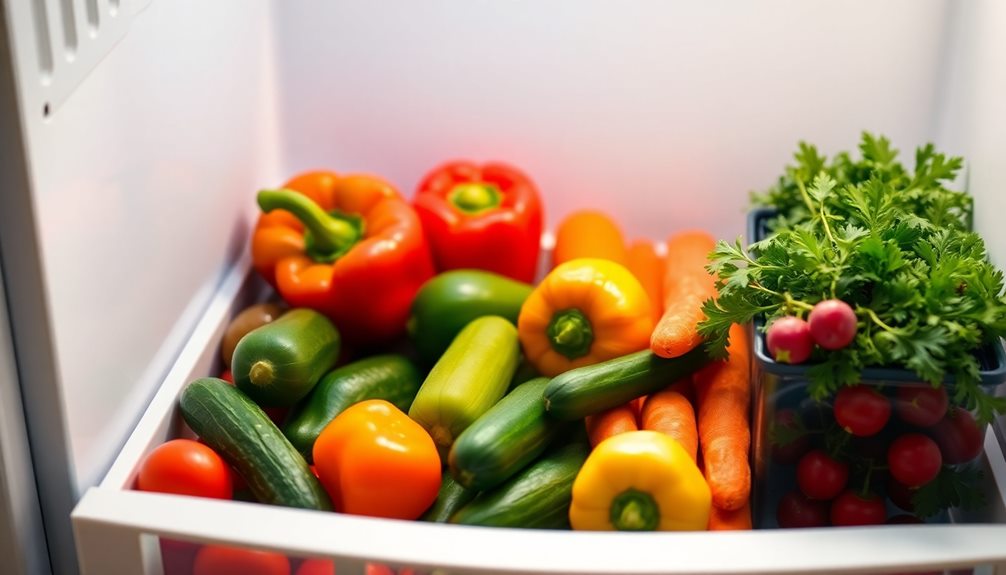
When it comes to keeping your fruits and vegetables fresh, knowing which ones belong in the low-humidity drawer is essential. This drawer is perfect for ethylene-producing fruits and certain vegetables that thrive in a drier environment.
By storing these items in low humidity, you allow them to ripen properly without spoiling too quickly.
Here are some great options for your low-humidity drawer:
- Apples and pears: These fruits emit ethylene gas, which can speed up ripening, so airflow is key.
- Bell peppers and cucumbers: These vegetables also benefit from low humidity, helping them stay crisp and fresh.
- Berries: Strawberries and raspberries should be kept here to avoid excess moisture that can lead to mold.
Common Crisper Drawer Mistakes
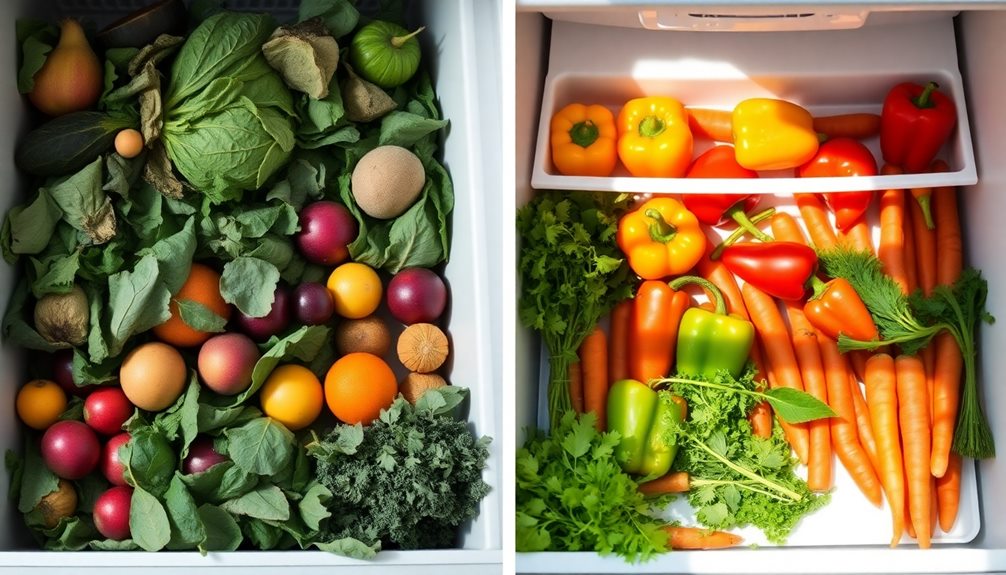
You mightn't realize it, but overcrowding your crisper drawer can lead to spoilage by restricting airflow around your produce.
Pairing ethylene-producing fruits with sensitive items could also speed up spoilage, leaving you with wilted greens and overripe fruits.
Avoid these common mistakes to keep your fruits and veggies fresh longer.
Overcrowding Leads to Spoilage
Overcrowding your crisper drawer can spell disaster for your fresh produce. When you stuff it beyond two-thirds capacity, you restrict airflow, leading to humidity buildup that accelerates spoilage.
Moisture can turn your leafy greens into a soggy mess or freeze delicate items, like herbs, due to poor circulation.
Imagine opening your crisper drawer to find:
- wilted spinach with slimy edges
- bruised avocados that are already brown
- fuzzy mold creeping on forgotten carrots
These issues arise when you ignore the significance of space in your crisper.
Plus, mixing ethylene-producing fruits—like apples and avocados—with ethylene-sensitive vegetables can send spoilage rates skyrocketing.
Regularly inspecting and rotating your produce is essential; if you overlook this, you could end up with items that are past their prime, wilting away or rotting in silence.
Improper Produce Pairing
Improper produce pairing can wreak havoc on the freshness of your fruits and vegetables. Mixing ethylene-emitting fruits, like apples and avocados, with ethylene-sensitive items, such as leafy greens, accelerates spoilage and diminishes quality. Here's a quick guide to help you avoid these common mistakes:
| Ethylene-Emitting Fruits | Ethylene-Sensitive Items | Recommended Humidity Settings |
|---|---|---|
| Apples | Leafy Greens | High |
| Bananas | Cucumbers | Low |
| Peaches | Berries | Medium |
| Avocados | Carrots | Low |
Overcrowding your crisper drawers limits airflow, trapping moisture and potentially freezing delicate veggies. Also, failing to separate fast-ripening fruits from other produce can lead to overripe items, ruining your stash.
Don't forget to adjust humidity settings based on the type of produce you're storing. High-humidity drawers can cause wilting, while low-humidity ones may lead to premature spoilage. Regularly clean your crisper drawers to prevent contamination and unpleasant odors that can affect your fresh finds.
Optimal Organization Tips
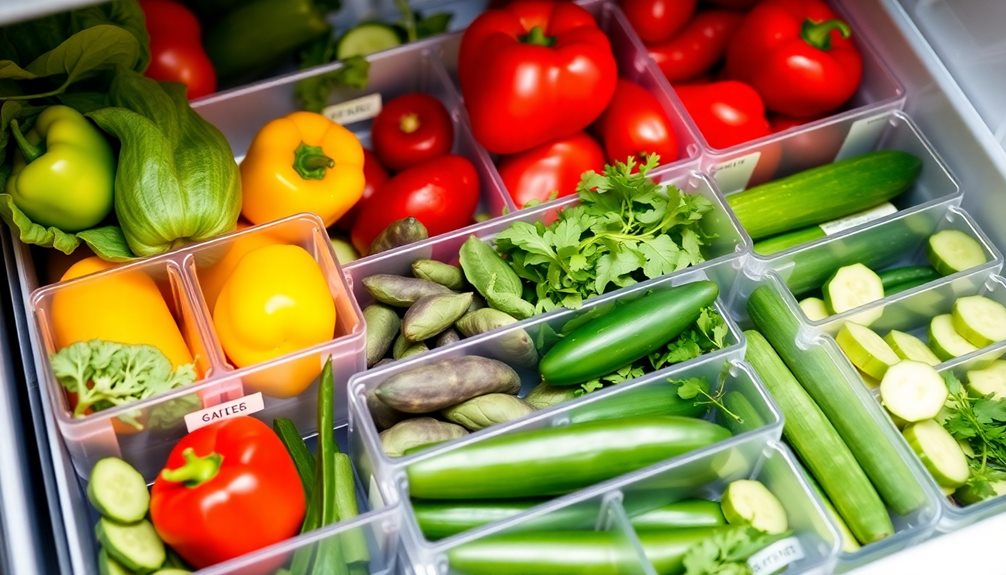
Efficient organization of your crisper drawer can greatly extend the life of your produce. Start by designating one drawer for high-humidity items, like cucumbers and fresh herbs, while using another for low-humidity items, such as apples and pears. This separation will help prevent spoilage caused by ethylene gas.
Incorporating energy-efficient appliances can also enhance your overall kitchen organization and food preservation methods, as seen in top energy-efficient kitchen appliances.
To optimize your space, consider these tips:
- Place leafy greens and shorter-lived items at the front for easy access.
- Store longer-lasting produce like carrots and cabbage toward the back.
- Keep your crisper drawer filled to about two-thirds capacity to guarantee proper airflow and humidity levels.
Implement a front-to-back storage method to encourage using older fruits and vegetables first, minimizing waste and preventing over-ripening.
Regularly check and rotate your produce to maintain freshness, guaranteeing everything gets consumed before it spoils. By following these organization tips, you'll not only keep your crisper drawer tidy but also prolong the life of your fruits and vegetables, allowing you to enjoy them at their best.
Benefits of Proper Storage
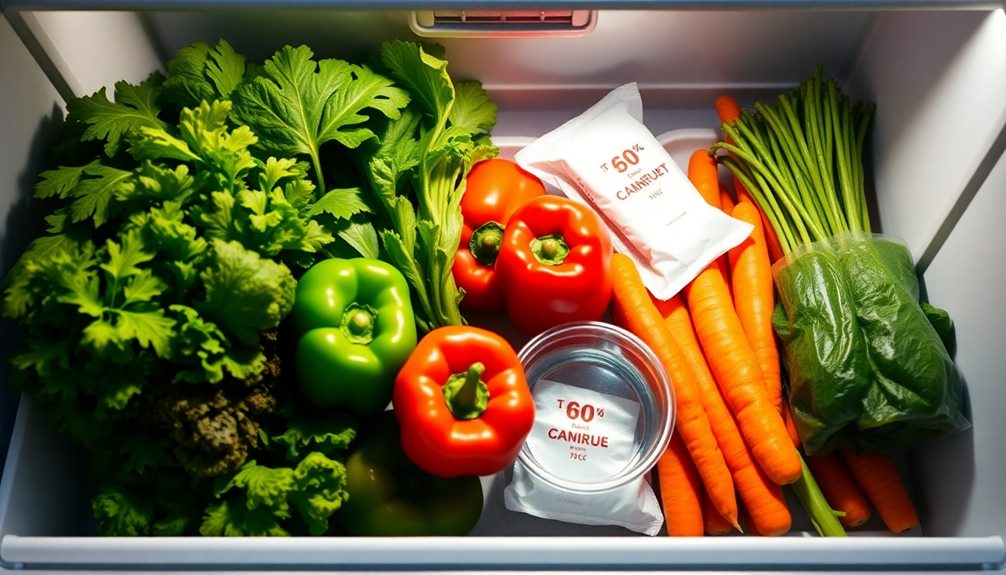
Maximizing the benefits of proper storage in your crisper drawer can greatly enhance the longevity of your fruits and vegetables. By utilizing humidity drawers effectively, you can extend the shelf life of your produce, minimizing waste and saving money.
High-humidity settings are perfect for leafy greens and thin-skinned vegetables, as they help to keep moisture and prevent wilting. On the other hand, low-humidity settings work best for ethylene-producing fruits like apples and avocados, allowing for airflow that helps to keep them fresh longer.
Regularly organizing and inspecting your crisper drawer is essential. It not only enhances visibility but also guarantees older items are consumed first, which notably reduces spoilage risks.
When you store your fruits and vegetables properly, you create an environment that encourages healthier eating habits, making fresh produce easily accessible for meal preparation.
Incorporating these practices into your routine won't only optimize the lifespan of your fruits and vegetables but also improve your overall kitchen efficiency.
Managing Ethylene Gas
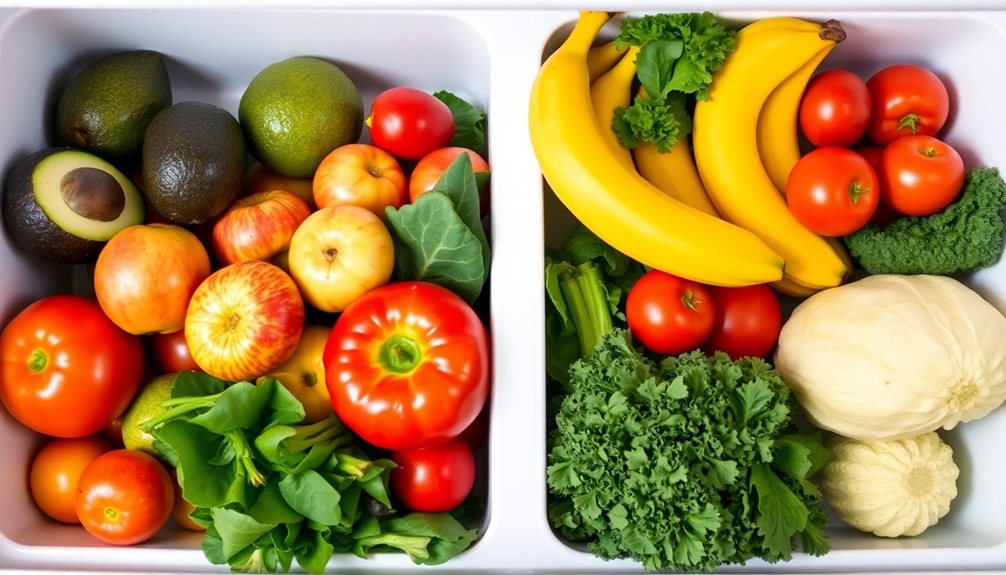
Understanding how to manage ethylene gas is key to maintaining the freshness of your produce. Ethylene is a natural plant hormone produced by certain fruits that can accelerate ripening and spoilage in ethylene-sensitive items.
To keep your fresh produce in top shape, you need to separate ethylene producers from sensitive vegetables.
- Store ethylene-producing fruits like apples, bananas, and avocados in low-humidity drawers.
- Keep ethylene-sensitive items such as lettuce, broccoli, and cucumbers in high-humidity drawers.
- Regularly inspect all stored produce for signs of ripening or spoilage.
Additional Storage Insights
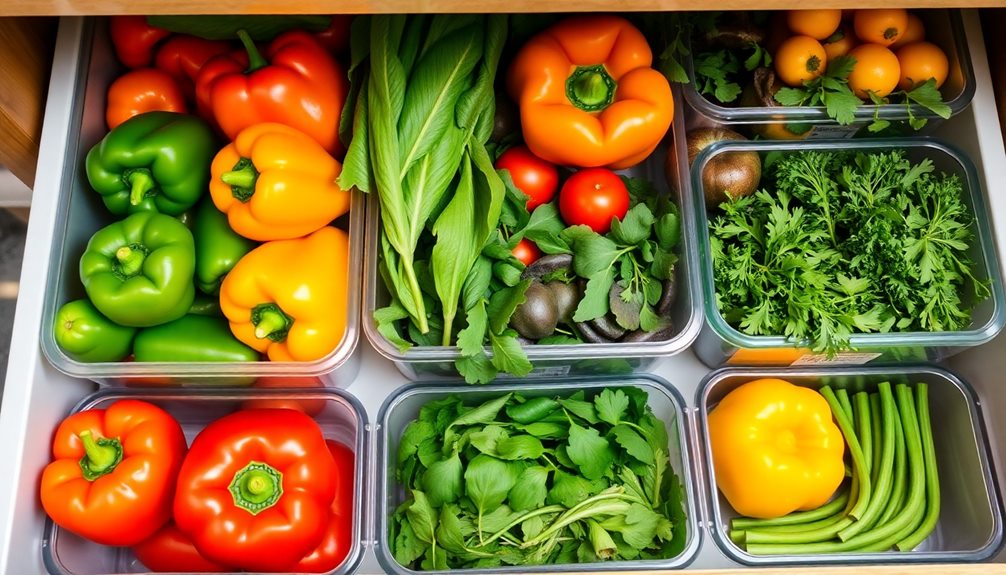
When it comes to keeping your produce fresh, knowing how to store various items properly can make all the difference.
For instance, fresh herbs like cilantro and parsley thrive when wrapped in damp paper towels and placed in a perforated bag inside the crisper drawer. This method helps maintain the right humidity level to keep them fresh and vibrant.
On the other hand, mushrooms should be stored in a paper bag instead of plastic. Plastic traps moisture and can lead to slime and spoilage.
Cheese also requires special attention; keep it in its original packaging or wrapped in wax paper to preserve freshness and prevent it from absorbing unwanted odors.
Cooking Tips and Resources
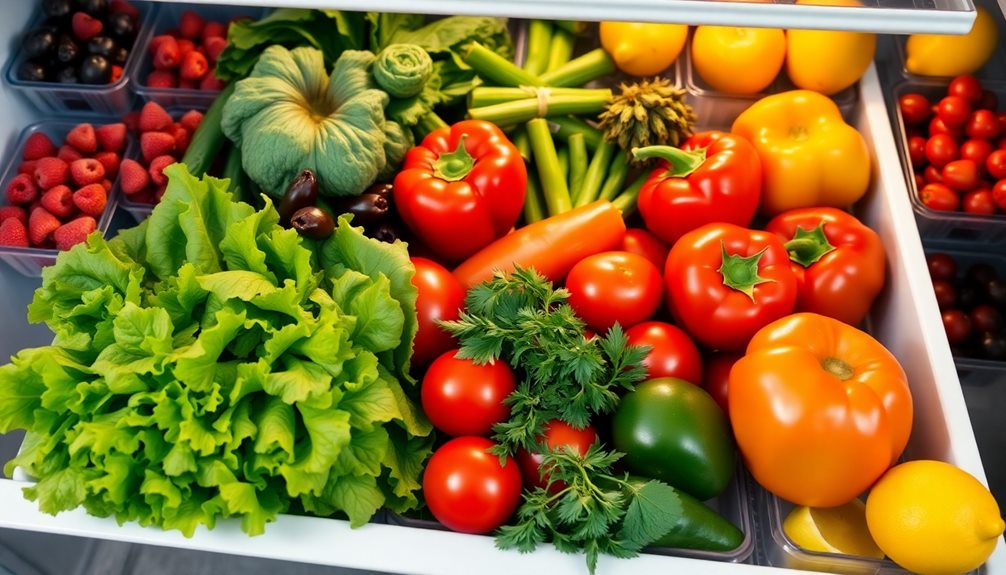
To elevate your cooking game, tapping into various resources can provide you with the inspiration and skills you need. By utilizing these tools, you'll not only enhance your cooking skills but also help keep your produce fresher and reduce food waste.
Consider these great resources:
- Bon Appétit's Daily Newsletter: Get cooking tips, recipes, and inspiration tailored for home cooks right in your inbox.
- BA Bake Club: Join a community of baking enthusiasts who share recipes and offer valuable baking advice.
- Dinner SOS Podcast: Find quick solutions for your cooking dilemmas with expert tips for those kitchen emergencies.
Membership with Epicurious opens the door to a vast database of expert-tested recipes and meal planning resources.
Whether you're looking to master a new dish or need advice on how to store your produce in the refrigerator crisper, these resources have you covered.
Embrace these cooking tips and watch your culinary skills flourish while minimizing food waste. Immerse yourself and discover a world of flavors and techniques waiting for you!
Frequently Asked Questions
What Food Goes in the Crisper Drawer?
You should store leafy greens, cucumbers, and herbs in the high-humidity drawer, while apples, avocados, and peaches belong in the low-humidity section. Organize them by shelf life for easy access and freshness.
What Vegetables Should Be Stored in High Humidity?
You might think waterlogged veggies are a disaster, but high humidity's perfect for cucumbers, lettuce, and leafy greens. They thrive in moisture, staying crisp and fresh—just don't overstuff that crisper drawer or spoilage'll happen!
Should Cheese Go in a Crisper Drawer?
You shouldn't store cheese in the crisper drawer. Instead, keep it in the main refrigerator compartment, wrapped properly, to maintain freshness and prevent moisture accumulation, which can lead to spoilage and strong odors.
Can Fruits and Vegetables Be Stored in the Same Crisper Drawer?
Did you know that mixing fruits and vegetables can cause spoilage rates to increase by up to 30%? It's better to keep them separate in your crisper drawer for ideal freshness and longer shelf life.
Conclusion
Now that you know what foods really belong in the crisper drawer, you can reveal the secret to fresher produce. Think of it as your fridge's own Garden of Eden, where proper storage keeps your fruits and veggies thriving. By managing humidity levels and avoiding common mistakes, you'll savor every bite of your culinary creations. So, next time you reach for that drawer, remember: it's not just storage; it's a path to deliciousness!
